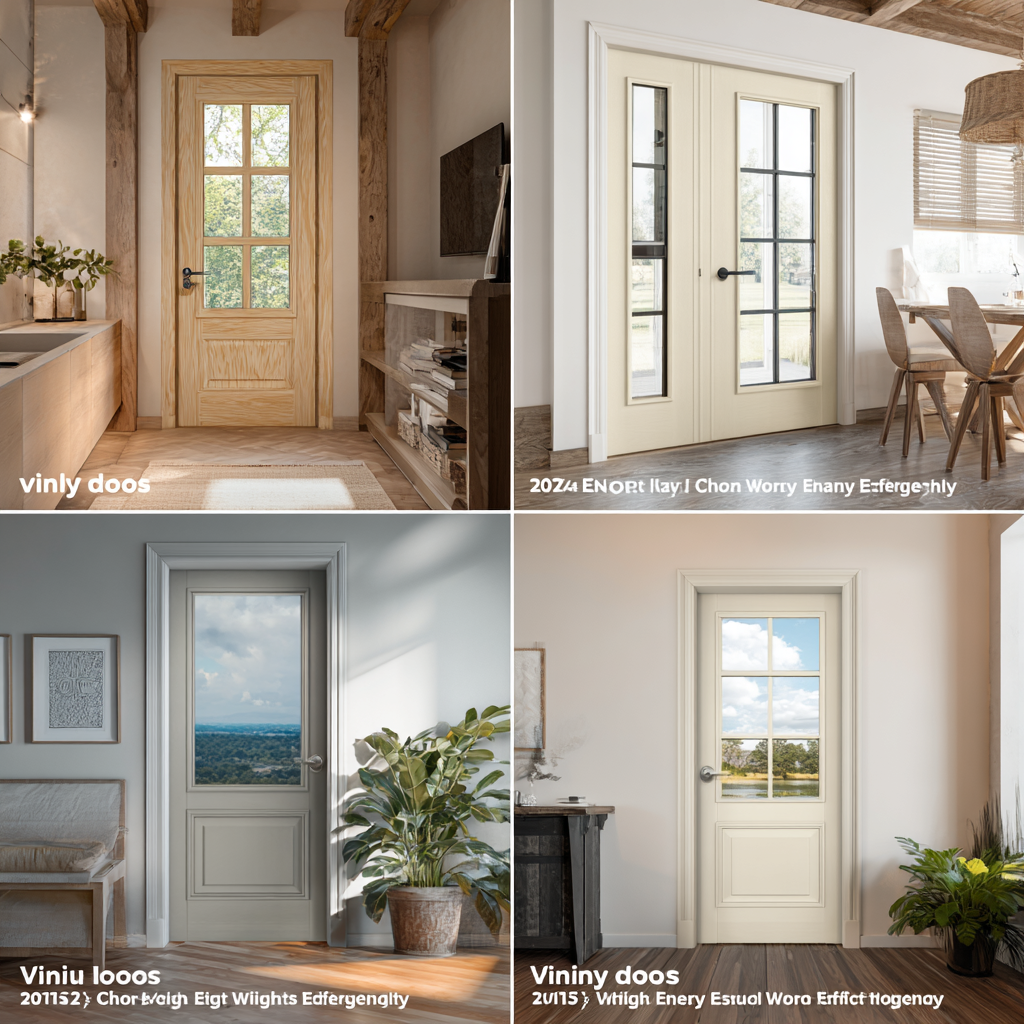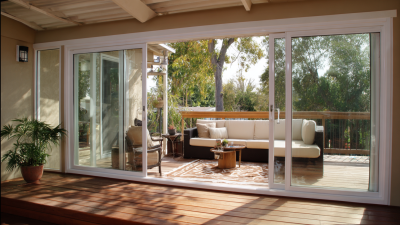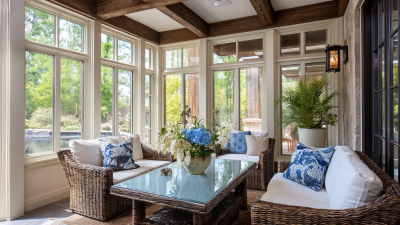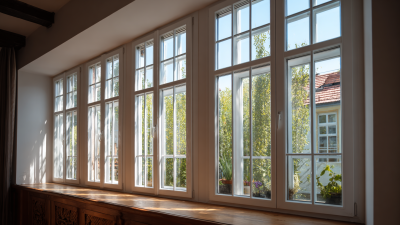2025 How to Choose Vinyl Doors for Maximum Energy Efficiency and Durability
 In the quest for superior energy efficiency and durability in home construction, vinyl doors have emerged as a preferred choice for many homeowners and builders alike. According to the 2023 report by the American Architectural Manufacturers Association, vinyl doors provide insulation values that can significantly reduce heating and cooling costs, promoting a sustainable living environment. "Choosing the right vinyl door can lead to up to 30% energy savings compared to traditional wood or metal options," emphasizes Dr. James Eldridge, a leading expert in door technology and energy efficiency.
In the quest for superior energy efficiency and durability in home construction, vinyl doors have emerged as a preferred choice for many homeowners and builders alike. According to the 2023 report by the American Architectural Manufacturers Association, vinyl doors provide insulation values that can significantly reduce heating and cooling costs, promoting a sustainable living environment. "Choosing the right vinyl door can lead to up to 30% energy savings compared to traditional wood or metal options," emphasizes Dr. James Eldridge, a leading expert in door technology and energy efficiency.
As we move towards 2025, selecting vinyl doors that align with the latest advancements in technology and design will be crucial for maximizing performance. These doors not only enhance aesthetic appeal but also offer robust resistance against weather elements and wear, ensuring longevity. Industry studies indicate that properly installed vinyl doors can last up to 20 years with minimal maintenance, making them a smart investment for homeowners. In this article, we will explore the top five considerations for choosing vinyl doors that not only meet your energy efficiency needs but also stand the test of time.
Key Features to Look for in Energy-Efficient Vinyl Doors
When selecting vinyl doors for energy efficiency and durability, several key features stand out. First, it is essential to consider the door's insulation properties. According to the American Council for an Energy-Efficient Economy (ACEEE), doors with a high R-value, typically above 5, can significantly reduce heating and cooling costs. This thermal resistance ensures that your home remains comfortable regardless of external conditions, contributing to long-term energy savings.
Another critical factor is the weatherstripping and seals. According to the US Department of Energy, sufficient weather stripping can prevent up to 25% of energy loss in an average home. Look for vinyl doors with multi-point locking systems that enhance not just security but also seal integrity. High-quality gaskets are necessary for reducing air leaks, which directly affects the door’s energy efficiency. Furthermore, selecting doors with a low U-factor, ideally below 0.30, can improve energy performance, providing a robust barrier against temperature fluctuations and external elements. These considerations will help you choose vinyl doors that not only boost energy efficiency but also offer lasting durability for your home.
2025 How to Choose Vinyl Doors for Maximum Energy Efficiency and Durability - Key Features to Look for in Energy-Efficient Vinyl Doors
| Feature | Description | Energy Efficiency Rating | Durability Rating |
|---|---|---|---|
| Insulation | High-performance insulation helps reduce heat transfer. | R-Value: 5.0 | 5 Years |
| Weatherstripping | Quality weatherstripping minimizes air leaks, improving efficiency. | Air Leakage: 0.3 cfm/ft² | 7 Years |
| Frame Material | Quality vinyl frames resist warping and are low maintenance. | UV Resistance: 25 Years | 10 Years |
| Glazing | Double or triple glazing options improve insulation and reduce noise. | U-Value: 0.28 | 5 Years |
| Finish | Durable finishes enhance weather resistance and aesthetics. | Fading Resistance: 10 Years | 15 Years |
Understanding the Durability Ratings of Vinyl Doors
When selecting vinyl doors, understanding their durability ratings can significantly impact both energy efficiency and lifespan. According to the American Society for Testing and Materials (ASTM), durability ratings measure a door's ability to withstand various environmental stressors, including temperature fluctuations, UV exposure, and physical impact. A higher durability rating often correlates with enhanced energy efficiency, as superior materials insulate better, reducing heating and cooling costs. For instance, a study by the Department of Energy indicates that high-rated vinyl doors can save homeowners up to 15% on their energy bills compared to lower-rated options.
The durability of vinyl doors is often quantified using a scale that considers factors such as impact resistance and weatherability. Products with a rating of 5 or higher on the industry standard scale are generally recognized for their exceptional performance. A report from the National Fenestration Rating Council (NFRC) emphasizes that well-rated vinyl doors can endure harsh weather conditions for 20 years or more without significant wear. This longevity not only enhances energy efficiency but also proves to be a cost-effective choice for homeowners looking to invest in durable, long-lasting solutions.
Comparing Different Insulation Options for Vinyl Doors
When selecting vinyl doors, one of the most critical elements to consider is the type of insulation used. Different insulation materials can significantly influence the energy efficiency and durability of the door. Common options include polystyrene, polyurethane, and expanded polystyrene, each offering varying degrees of thermal resistance and structural integrity. Polystyrene is often favored for its cost-effectiveness and decent insulation properties, making it suitable for moderate climates.
On the other hand, polyurethane insulation provides superior thermal performance and is known for its strength and durability. This insulation option is particularly advantageous in extreme weather conditions, as it helps maintain a stable indoor temperature while minimizing energy costs. Expanded polystyrene, while less common, provides a lightweight solution that is easier to install. Choosing the right insulation involves assessing your local climate, energy efficiency goals, and budget, ensuring that the vinyl doors not only enhance your home's aesthetics but also support long-term sustainability.
Energy Efficiency Comparison of Vinyl Doors Insulation Options
Maintenance Tips for Longevity and Performance of Vinyl Doors
When it comes to maintaining vinyl doors for longevity and performance, regular care is essential. One of the key tips is to clean the doors frequently using a gentle soap solution and a soft cloth. This prevents dirt buildup that can lead to scratches and damage over time. Additionally, make sure to inspect the seals around the doors regularly. If you notice any cracks or wear, replacing them can prevent air leaks and enhance energy efficiency.

Another important aspect of maintenance is weatherproofing. Ensure that the door frames are properly sealed to resist moisture infiltration, which can weaken the structural integrity of the doors. Applying a silicone-based sealant around the edges can help maintain a strong barrier against water. Furthermore, lubricating the door hinges and locks annually will not only enhance functionality but also prevent rust and corrosion that can occur over time.
Finally, consider the placement of your vinyl doors. Protecting them from extreme weather conditions with awnings or overhangs can significantly prolong their lifespan. By following these maintenance tips, you can ensure your vinyl doors remain both energy-efficient and durable throughout the years.
Cost vs. Long-Term Savings: Investing in High-Quality Vinyl Doors
When evaluating the cost versus long-term savings of vinyl doors, it is essential to consider not only the initial investment but also the durability and energy efficiency they offer. High-quality vinyl doors might come with a higher price tag, but their robust construction often translates to lower energy bills over time. These doors are designed to insulate better, reducing heat loss in the winter and keeping cool air inside during the summer months. This energy efficiency can lead to significant savings on heating and cooling costs, making the initial purchase more economical in the long run.
Moreover, investing in premium vinyl doors can also minimize maintenance expenses. Cheaper options may require frequent repairs or replacements, which can add up over the years. In contrast, high-quality vinyl doors are resistant to fading, cracking, and warping, ensuring they stand the test of time. Thus, while the upfront cost may be higher, the longevity and minimal maintenance required with quality vinyl doors make them a sound financial decision for homeowners focused on both energy efficiency and durability.

Related Posts
-

Exploring Varieties of Vinyl Windows and Doors and Their Unique Applications
-

7 Compelling Reasons to Choose Vinyl Patio Doors for Your Home Upgrade
-

Why Choosing Exterior Sliding Doors Can Transform Your Living Space
-

Unparalleled Chinese Craftsmanship in Best Patio Windows for Global Buyers
-

How to Choose the Best Custom Made Windows for Your Global Sourcing Needs: Insights and Tips
-

Unlocking the Secrets to Designing Best Custom Made Sliding Doors for Your Home